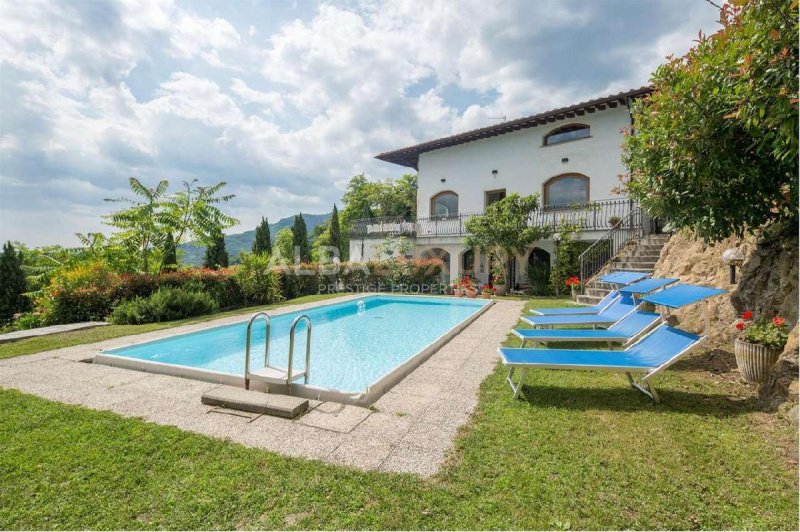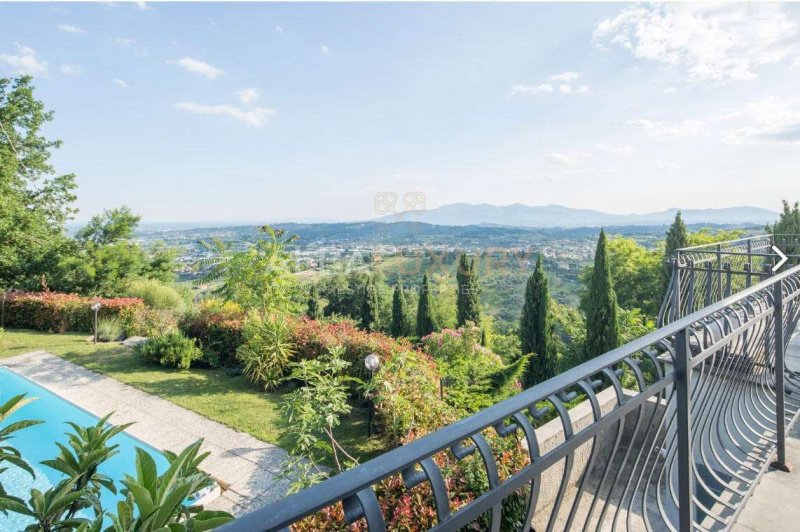₪3,891,690
(990,000 €)
12间卧室别墅, 792 m² 佩夏, Pistoia (省)


- 1 / 39
- 2 / 39
- 3 / 39
- 4 / 39
- 5 / 39
- 6 / 39
- 7 / 39
- 8 / 39
- 9 / 39
- 10 / 39
- 11 / 39
- 12 / 39
- 13 / 39
- 14 / 39
- 15 / 39
- 16 / 39
- 17 / 39
- 18 / 39
- 19 / 39
- 20 / 39
- 21 / 39
- 22 / 39
- 23 / 39
- 24 / 39
- 25 / 39
- 26 / 39
- 27 / 39
- 28 / 39
- 29 / 39
- 30 / 39
- 31 / 39
- 32 / 39
- 33 / 39
- 34 / 39
- 35 / 39
- 36 / 39
- 37 / 39
- 38 / 39
- 39 / 39
主要特点
- 花园
- 游泳池
- 露台
描述
该物业由4个已经分割的住宅单元组成,或可用于单一的独立物业。
属性描述 SQM. 330
物业描述 B SQM. 110
物业描述 C SQM. 240
物业描述 D SQM. 112
酒店享有佩西亚市和皮斯托亚和卢卡之间的平原的迷人景色,由10个花园的楼梯组成,通向一个大露台,享有占地 30,000 平方米的花园的迷人景色。
该建筑群由几个单元组成:
缩放 三层独立别墅,私人花园和游泳池。
2。 独立起居单元位于第一座建筑的一楼部分。
3 个。 农舍三层,全景阳台,在一楼提供大型地下室房间。
4. 时间轴: 时间轴: 时间轴: 时间轴: 时间轴: 时间轴: 时间轴: 时间轴: 时间轴: 时间轴: 时间轴: 时间轴: 时间轴: 生活单元在两层。
结构的美丽和广阔,允许它私人使用或接受旅游用途。
因此,考虑一个迷人的别墅周围环绕着一个非凡的景观,包括橄榄树林和树林。
领土:
佩西亚市具有古老的中世纪起源; 被河流分割,它明显以两个城市部门为特征: 大教堂和市政宫,大广场延伸。
佩西亚市具有古老的中世纪起源; 被河流分割,它明显以两个城市部门为特征: 大教堂和市政宫,大广场延伸。 古老的建筑和优雅的教堂是历史中心的特色,尽管经历了重大的干预,但仍然有其原有的形状。 东部是圆形城市核心,起源于Pieve di S。 玛丽亚,今天的大教堂; 然而,在西部,Civitas的核心是用独特的城市设计开发的,正是广场和市政代表的建筑; 后者源自佩西亚城堡,在中世纪,该城堡位于卢卡主教的管辖之下。 Ponte del Duomo将这两根柱子团结起来,如此明显的分裂,"宗教和民间"。 佩西亚正是由于其城市布局和丰富的历史活动,一段时间以来,它一直是伟大的,因为瓦尔迪尼沃勒的首都。 佩西亚拥有丰富的文献和艺术证据,今天仍然出现一个迷人的地方,在那里您可以在周围的绿色山丘和典型的街道之间度过几天,这些街道揭示了传统和数百年的历史。 佩西亚的第一张图像可以追溯到十五世纪,并突出了两个位置(城堡-披萨)和通往河流的陡峭山丘。 1339年,佩西亚城堡在卢卡统治下经过了数百年的历史,在佛罗伦萨统治下经过。 1339年2月6日,佛罗伦萨进入佩西亚,从那一刻起,社区跟随"生活"政府的命运。 伟大的教堂结构,尽管几乎都有一个中世纪的基础,在十七世纪经历了强大的建筑和装饰装修。 事实上,在17世纪,佩西亚经历了更好的艺术和政治季节; 社区开始拥有更城市化的结构; 直到那时,小的体制现实具有更多的家庭特色,因此,可以说,开始成为当地社会的真正服务。 佩西亚市占地79.14平方公里。 其主要旅游景点的中心是瓦莱里亚纳城堡和科洛迪村,这是著名的全世界,因为皮诺基奥冒险的作者想叫自己的名字这个村庄的名字。 今天,佩西亚市以其花卉生产和意大利中部花卉销售中心而闻名。
能量类: D 121.11千瓦时 / m3 a
广告商输入的描述
The property consists of 4 residential units which have already been divided up, or can be used as a single independent property.
Property Description A SQM 330
Description Property B SQM 110
Description of Property C SQM 240
Description of Property D SQM 112
The property offers an enchanting view over the city of Pescia and the plain between Pistoia and Lucca and is composed of a staircase of 10 gardens which lead to a large terrace which offers an enchanting view over the garden which boasts 30,000 sqm.
The property complex consists of several units:
1. Independent villa on three levels, private garden and swimming pool.
2. Independent living unit located on the ground floor as part of the first building.
3. Farmhouse on three floors, panoramic veranda, the ground floor offers a large tavern room.
4. Residential unit on two levels.
The beauty and vastness of the structure allow it to be used for private use or for tourist accommodation.
It is therefore considered an enchanting villa immersed in an extraordinary landscape of olive groves and woods.
Territory:
The town of Pescia has ancient medieval origins; divided by the river, it is clearly distinguished by two urban sectors: that of the Cathedral and that of the Palazzo Comunale, where the large square extends.
The city of Pescia has ancient medieval origins; divided by the river, it is clearly distinguished by two urban sectors: the Cathedral and the Palazzo Comunale, where the large square extends. Ancient palaces and elegant churches characterise the historical centre, which, despite having undergone considerable interventions, still possesses its original shape. To the east is the circular urban core that originated from the Pieve di S. Maria, today the Cathedral; to the west, on the other hand, the nucleus of the civitas, with the square and the palaces of the municipal representatives, develops with a singular longitudinal urban design; the latter originated from the castle of Pescia, which in the Middle Ages was under the jurisdiction of the Bishop of Lucca. The Ponte del Duomo unites these two poles so clearly divided, the 'religious and the civil'. Pescia, precisely because of its urban layout and eventful history, has since time immemorial been considered the capital of the Valdinievole. Rich in documentary and artistic evidence, Pescia still appears today as a fascinating place where one can spend days amidst the surrounding green hills and characteristic streets that tell of a centuries-old tradition and history. The earliest images of Pescia date back to the 15th century and emphasise the two posts (castle-pieve) and the steep hill that descends towards the river. In 1339 the castle of Pescia, after a centuries-long history under the rule of Lucca, came under Florence. On 6 February 1339, the Florentines entered Pescia and from that moment on, the community followed the fate of the 'lily' government. Although almost all the large church structures have a medieval foundation, they underwent major architectural and decorative alterations in the 17th and 18th centuries. In the 17th century, in fact, Pescia experienced its best artistic and political season; the community began to have a more citizen-like structure; the small institutions, which up to that time had had a more family-like character, began, so to speak, to become real services for local society. The municipality of Pescia covers a territorial surface area of 79.14 km2. Its main centres of tourist attraction are the Valleriana Castles and the village of Collodi, which is world famous because the author of the Adventures of Pinocchio wanted to be named after it. Today, the town of Pescia is known for its floricultural production and as the commercial centre for flowers in Central Italy.
La proprietà è composta da 4 unità abitative già frazionate, oppure puó essere destinata ad un unica proprietà indipendente.
Descrizione Immobile A MQ. 330
Descrizione Immobile B MQ. 110
Descrizione Immobile C MQ. 240
Descrizione Immobile D MQ. 112
La proprietà propone un'incantevole vista sulla città di Pescia e sulla pianura tra Pistoia e Lucca è composta da una scalinata di 10 giardini che conducono ad una grande terrazza che offre un'incantevole vista sul giardino che vanta 30.000 mq.
Il complesso immobiliare composto da diverse unità:
1. Villa indipendente disposta su tre livelli, giardino privato e piscina.
2. Unità abitativa indipendente situata al piano terra parte del primo edificio.
3. Casa colonica disposta su tre piani, veranda panoramica, al piano terra propone un ampio locale taverna.
4. Unità abitativa su due livelli.
La bellezza e la vastità della struttura le consentono un uso privato oppure un utilizzo turistico ricettivo.
Considerata dunque un'incantevole villa immersa in un paesaggio straordinario composto da oliveti e boschi.
Territorio:
La città di Pescia ha antiche origini medievali; divisa dal fiume, è nettamente contraddistinta da due settori urbani: quello della Cattedrale e quello del Palazzo Comunale, ove si estende la grande piazza.
La città di Pescia ha antiche origini medievali; divisa dal fiume, è nettamente contraddistinta da due settori urbani: quello della Cattedrale e quello del Palazzo Comunale, ove si estende la grande piazza. Antichi palazzi ed eleganti chiese caratterizzano il centro storico che, nonostante abbia subito notevoli interventi, possiede ancora la sua forma originaria. Ad est è il nucleo urbano di forma circolare che prese origine dalla Pieve di S. Maria, oggi Cattedrale; ad ovest invece si sviluppa con un singolare disegno urbano longitudinale il nucleo della civitas, con appunto la piazza ed i palazzi delle rappresentanze comunali; quest'ultimo ebbe origine dal castello di Pescia che in età medievale era sotto la giurisdizione del Vescovo di Lucca. Il Ponte del Duomo unisce questi due poli così nettamente divisi, il “religioso e il civile”. Pescia, proprio per il suo assetto urbano e per la sua storia ricca di avvenimenti, è da tempo immemorabile considerata il capoluogo della Valdinievole. Ricca di testimonianze documentarie ed artistiche, Pescia appare ancora oggi un luogo affascinante dove si possono trascorrere giorni tra i verdi colli circostanti e le caratteristiche strade che raccontano una tradizione e una storia plurisecolare. Le prime immagini di Pescia risalgono al Quattrocento e mettono in risalto le due postazioni (castello-pieve) e la collina ripida che scende proprio verso il fiume. Nel 1339 il castello di Pescia, dopo una storia plurisecolare sotto il dominio lucchese, passó sotto Firenze. Il 6 febbraio 1339 i fiorentini entrarono in Pescia e da quel momento la comunità seguì le sorti del governo del “giglio”. Le grandi strutture chiesastiche, pur avendo quasi tutte una fondazione medievale, hanno subito forti rimaneggiamenti architettonici e decorativi nel Sei-Settecento. Nel XVII secolo, infatti, Pescia conobbe la sua stagione artistica e politica migliore; la comunità inizió ad avere un assetto più cittadino; le piccole realtà istituzionali, che fino a quel momento avevano avuto un carattere più famigliare, iniziarono, per così dire, a diventare veri e propri servizi per la società locale. Il Comune di Pescia si estende su una superficie territoriale di 79,14 Km2. I suoi centri di maggiore attrazione turistica sono i Castelli della Valleriana e il paese di Collodi che è famoso in tutto il mondo perché l'autore delle Avventure di Pinocchio volle chiamarsi con il nome di questo paese. Oggi la città di Pescia è nota per la produzione florovivaistica e per il centro di commercializzazione dei fiori dell'Italia Centrale.
CLASSE ENERGETICA: D 121,11 kWh/m3 a
Die Liegenschaft besteht aus 4 Wohneinheiten, die bereits aufgeteilt sind, oder als eigenständige Liegenschaft genutzt werden können.
Beschreibung A SQM 330
Beschreibung Eigenschaft B SQM 110
Beschreibung der Eigenschaft C SQM 240
Beschreibung der Eigenschaft D SQM 112
Das Anwesen bietet einen bezaubernden Blick auf die Stadt Pescia und die Ebene zwischen Pistoia und Lucca und besteht aus einer Treppe von 10 Gärten, die zu einer großen Terrasse führen, die einen bezaubernden Blick auf den Garten bietet, der 30.000 qm groß ist.
Der Immobilienkomplex besteht aus mehreren Einheiten:
1. Unabhängige Villa auf drei Ebenen, privater Garten und Schwimmbad.
2. Unabhängige Wohneinheit im Erdgeschoss des ersten Gebäudes.
3. Bauernhaus auf drei Etagen, Panorama-Veranda, bietet das Erdgeschoss eine große Taverne Zimmer.
4. Wohneinheit auf zwei Ebenen.
Die Schönheit und Weite des Bauwerks ermöglicht die Nutzung für den privaten Gebrauch oder als Touristenunterkunft.
Es handelt sich also um eine bezaubernde Villa, die in eine außergewöhnliche Landschaft mit Olivenhainen und Wäldern eingebettet ist.
Territorium:
Die Stadt Pescia hat antike mittelalterliche Ursprünge; sie wird durch den Fluss geteilt und unterscheidet sich deutlich durch zwei städtische Bereiche: den der Kathedrale und den des Palazzo Comunale, wo sich der große Platz erstreckt.
Die Stadt Pescia hat antike mittelalterliche Ursprünge; sie wird durch den Fluss geteilt und zeichnet sich durch zwei städtische Bereiche aus: den Dom und den Palazzo Comunale, wo sich der große Platz erstreckt. Antike Paläste und elegante Kirchen prägen das historische Zentrum, das trotz erheblicher Eingriffe seine ursprüngliche Form bewahrt hat. Im Osten befindet sich der kreisförmige Stadtkern, der aus der Pieve di S. Maria, der heutigen Kathedrale, hervorging; im Westen hingegen entwickelt sich der Kern der civitas mit dem Platz und den Palästen der städtischen Repräsentanten mit einem einzigartigen längsgerichteten Stadtgrundriss, der aus der Burg von Pescia hervorging, die im Mittelalter der Gerichtsbarkeit des Bischofs von Lucca unterstellt war. Die Ponte del Duomo vereint diese beiden so klar getrennten Pole, den "religiösen und den zivilen". Pescia gilt seit jeher als Hauptstadt der Valdinievole, gerade wegen seiner urbanen Struktur und seiner wechselvollen Geschichte. Reich an dokumentarischen und künstlerischen Zeugnissen, ist Pescia auch heute noch ein faszinierender Ort, an dem man inmitten der grünen Hügel und charakteristischen Straßen, die von einer jahrhundertealten Tradition und Geschichte erzählen, Tage verbringen kann. Die frühesten Abbildungen von Pescia stammen aus dem 15. Jahrhundert und betonen die beiden Pfosten (castle-pieve) und den steil zum Fluss abfallenden Hügel. Im Jahr 1339 kam die Burg von Pescia nach einer jahrhundertelangen Geschichte unter der Herrschaft von Lucca zu Florenz. Am 6. Februar 1339 marschierten die Florentiner in Pescia ein, und von da an folgte die Gemeinde dem Schicksal der "Lilien"-Regierung. Obwohl fast alle großen Kirchenbauten auf mittelalterlichen Fundamenten beruhen, wurden sie im 17. und 18. Jahrhundert architektonisch und dekorativ stark umgestaltet. Im 17. Jahrhundert erlebte Pescia in der Tat seine beste künstlerische und politische Zeit; die Gemeinde begann, eine bürgerlichere Struktur zu haben; die kleinen Institutionen, die bis dahin eher familiären Charakter hatten, begannen sozusagen, echte Dienste für die lokale Gesellschaft zu werden. Die Gemeinde Pescia erstreckt sich über eine Fläche von 79,14 km2. Die wichtigsten touristischen Anziehungspunkte sind die Valleriana-Schlösser und das Dorf Collodi, das weltberühmt ist, weil der Autor der Abenteuer von Pinocchio seinen Namen danach benannt haben wollte. Heute ist die Stadt Pescia für ihre Blumenproduktion und als Handelszentrum für Blumen in Mittelitalien bekannt.
Недвижимость состоит из 4 жилых единиц, которые уже разделены, или могут быть использованы как единая независимая собственность.
Описание недвижимости A SQM 330
Описание Свойство B SQM 110
Описание недвижимости C SQM 240
Описание недвижимости D SQM 112
С участка открывается чарующий вид на город Пешиа и равнину между Пистойей и Луккой. Он состоит из лестницы из 10 садов, которые ведут к большой террасе, откуда открывается чарующий вид на сад площадью 30 000 кв.м.
Имущественный комплекс состоит из нескольких единиц:
1. Независимая вилла на трех уровнях, частный сад и бассейн.
2. Независимый жилой блок, расположенный на первом этаже в составе первого здания.
3. Фермерский дом на трех этажах, панорамная веранда, на первом этаже находится большой зал таверны.
4. Жилой блок на двух уровнях.
Красота и простор сооружения позволяют использовать его для частного использования или для размещения туристов.
Поэтому она считается очаровательной виллой, погруженной в необыкновенный ландшафт оливковых рощ и лесов.
Территория:
Город Пешиа имеет древние средневековые корни; разделенный рекой, он четко выделяет два городских сектора: сектор Кафедрального собора и сектор Палаццо Комунале, где простирается большая площадь.
Город Пешиа имеет древние средневековые корни; разделенный рекой, он четко выделяет два городских сектора: Кафедральный собор и Палаццо Комунале, где простирается большая площадь. Старинные дворцы и элегантные церкви характеризуют исторический центр города, который, несмотря на значительные вмешательства, все еще сохраняет свой первоначальный облик. На востоке находится круговое городское ядро, возникшее из Пьеве ди Санта Мария, где сегодня находится кафедральный собор; на западе, с другой стороны, развивается ядро civitas, с площадью и дворцами муниципальных представителей, с необычной продольной городской планировкой; последняя возникла из замка Пешиа, который в средние века находился под юрисдикцией епископа Лукки. Понте дель Дуомо объединяет эти два полюса, так четко разделенные, "религиозный и гражданский". Пеша, именно благодаря своей городской планировке и богатой событиями истории, с незапамятных времен считается столицей Вальдиниеволе. Богатая документальными и художественными свидетельствами, Пеша и сегодня предстает как увлекательное место, где можно провести несколько дней среди окружающих зеленых холмов и характерных улочек, рассказывающих о многовековых традициях и истории. Самые ранние изображения Пешии относятся к 15 веку и подчеркивают два столба (замок-пьеве) и крутой холм, спускающийся к реке. В 1339 году замок Пешиа, после многовековой истории под властью Лукки, перешел под власть Флоренции. 6 февраля 1339 года флорентийцы вошли в Пешию, и с этого момента общину постигла участь правительства "лилии". Хотя почти все крупные церковные сооружения имеют средневековую основу, они претерпели значительные архитектурные и декоративные изменения в XVII и XVIII веках. В XVII веке Пеша пережила свой лучший художественный и политический сезон; сообщество стало иметь более гражданскую структуру; небольшие учреждения, которые до этого времени имели более семейный характер, стали, так сказать, настоящими службами для местного общества. Территория муниципалитета Пешиа составляет 79,14 км2. Главными центрами туристической привлекательности являются замки Валлерианы и деревня Коллоди, которая всемирно известна тем, что автор "Приключений Пиноккио" хотел, чтобы ее назвали в его честь. Сегодня город Пешиа известен своим цветоводческим производством и как коммерческий центр цветов в Центральной Италии.
细节
- 物业类型
- 别墅
- 状况
- N/A
- 房屋面积
- 792 m²
- 卧室
- 12
- 浴室
- 8
- 花园
- 30,000 m²
- 能效评级
- D121,11
- 参考代码
- Toscana 037
能效评级 (第90/2013号法律)
- A4
- A3
- A2
- A1
- B
- C
- D
- E
- F
- G
什么是能效评级?
能源效率评级是由字母A4到G所表示的值,该值表示基于建筑物外形和气候区等参数的建筑物的能源质量和消耗量。 能效评级越高,建筑物的空调能耗和成本就越低。 请注意:如果建筑物的外形和气候区域不同,则属于同一类别的建筑物的年能耗也可能大不相同。
什么是EPgl(全球能源绩效指数)
EPgl表示建筑或建筑单元达到舒适条件所消耗的能量,并基于现有的能源服务和标准使用下的物业类型。计量单位为kWh/m2/年。
距兴趣点的距离:
- 机场
31.0 km - Pisa PSA - Galileo Galilei
43.0 km - Firenze FLR - Amerigo Vespucci
86.0 km - Bologna BLQ - Guglielmo Marconi
107.0 km - Parma PMF - Giuseppe Verdi
- 高速公路出口
- 6.5 km
- 医院
- 1.3 km - Ospedale della Valdinievole
- 海岸
- 35.0 km
- 滑雪胜地
- 23.7 km
在此物业附近
- 外出吃饭
580 m - 酒吧
650 m - 餐厅 - Osteria dei Ricci
730 m - 快餐餐厅 - Pizza al Taglio di Coppi Cristina
740 m - 冰淇淋店
- 体育运动
330 m - 体育中心 - Tennis Club Colleviti - 网球
1.3 km - 健身房
14.6 km - 马术中心 - Pistoia Equestrian Centre
15.3 km - 高尔夫俱乐部 - Montecatini Golf
- 学校
770 m - 学校 - Scuola Statale Elementare e Media Andreotti
15.8 km - 高等教育机构 - Esedra Formazione Lucca
19.1 km - 大学 - Pistoia Nursery Campus
- 药房
- 640 m - 药房 - Farmacia del Vecchio Mercato
- 兽医
- 1.0 km - 兽医 - Ambulatorio Veterinario Ponte dei Marchi
佩夏:关于城市的信息
- 海拔
- 高出海平面62m
- 面积
- 79.12 km²
- 地理区域
- 内陆丘陵
- 人口
- 19250
您如何看待该广告的质量?
提供有关此广告的反馈,帮助我们改善您的Gate-away体验。
请不要评估物业本身,而只是评估其展示的质量。
